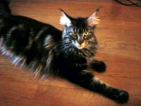Oh no!!!! Not tuna! Tuna causes a miserable and painful ailment in cats
called steatitis.
Here are some snips from previous posts regarding this problem:
Please, under no circumstances, feed you kitty tuna. Cats easily become
tuna junkies as the oil is very addicting. Tuna is considered a cat
allergen and can cause all sorts of illnesses - epilepsy, asthma,
hyperactivity and skin troubles. It also causes heavy metal intoxication
with such high amounts of mercury that leads to chronic UTIs, liver, kidney
and pancreatic damage. Tuna destroys the cats vitamin E stores and can also
cause a muscular dystrophy-like ailment called steatitis. If you must feed
tuna, supplement with E daily (even so - Es basically ineffective). The
heavy
metal poisoning is also a problem for us lowly humans as well. The fact that
it s in aluminum cans is dangerous, too.
Tuna can actually be fatal to cats - as fatal as chocolate (oxalic
acid in chocolate prevents calcium absorption in dogs. In cats it s the
theobromine that s fatal). First, they become hooked on the strong flavor;
Second, there s a high amount of polyunsaturated fat (the oil I refer
to)in tuna and a cat s system cannot metabolize it. If it is packed in a
vegetable oil (as in some commercial pet foods - great tuna parts as well)
this adds the additional danger of destroying the vitamin E in the system,
causing steatitis (a muscular dystrophy-type of ailment). This ailment
results in the cat s nerve endings becoming supersensitive and the animal
experiences pain whenever touched or held. Actually, supplementing w/vit. E
isn t good enough. Third, tuna does contain high amounts of mercury and is
systemically poisonous due to heavy metal intoxication.
Steatitis or Yellow Fat Disease is found primarily in cats and fur-bearing
animals (Minks). It is characterized by a marked inflammation of adipose
tissue and the deposition of ceroid (wax) pigment in the interstices
(small gaps) of the adipose (fat) tissue.
Etiology: It is believed that an overabundance of unsaturated fatty acids in
the food, together with a deficiency of vitamin E, results in the deposition
of the pigment in the fat. Most naturally occurring and experimentally
produced cases have occurred in animals that have had fish, or fish
by-products, as all or part of the diet; fish oil may be the primary agent.
Clinical Findings and Diagnosis: Affected cats are frequently plump and well
fed, usually young, and may be of either sex. They show loss of agility and
general unwillingness to move. Resentment is exhibited on palpation of the
back and abdomen. In the advanced cases, even a light touch will cause pain.
Fever is a constant finding and anorexia may be present. (I won t go into
the findings regarding mink unless there are some owners on the list that
wish this info).
The typical laboratory finding is an elevated leukocyte count, with
neutrophilia (high white blood cell count) and sometimes eosinophilia
(abnormally large number of eosinophils-red staining white blood cells-in
the circulating blood). Biopsy of the subcut. fat shows it to be yellowish
brown, with a nodular or granular appearance. Microscopic examination
reveals severe inflammatory changes and associated ceroid pigment.
Treatment: Elimination of the offending food from the diet is imperative.
The administration of vitamin E, in the form of a-tocopherol, at least 30 mg
daily for cats, or 15 mg daily for mink, is necessary. Antibiotics are of
doubtful value, in spite of the fever and leukocytosis. Administration of
fluids is not advisable unless dehydration exists and the animal should be
handled as little as possible.
Basically - a cat and mink ailment that is only caused by fish oil. I see
nothing in my veterinary texts regarding dogs or other animals getting this
problem.

































 pri nas se pa včasih prav bašemo s to tuno. Očitno bo le še za občasne poslastice - za nas in za mačko.
pri nas se pa včasih prav bašemo s to tuno. Očitno bo le še za občasne poslastice - za nas in za mačko. 


 .
.